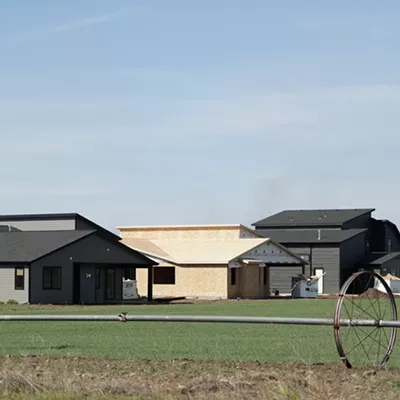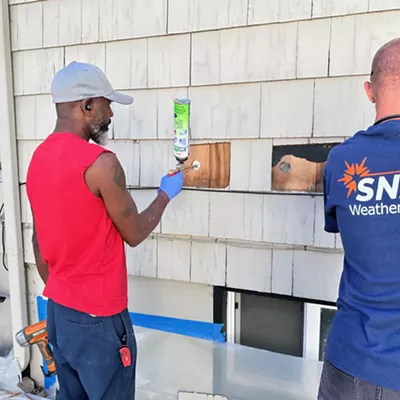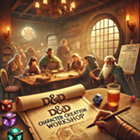In one image, La Frontera, a man stands in the desert with his back to the camera. His pants are cinched up around his waist and his back -- which is bare -- is tattooed with an image of the Virgin Mary that brings to mind the everyday devout religion of a Mexican prayer candle. In another, Gaucho, a striped-pajama-clad baby rests in the thick, worn hands of a cowboy whose upper half is obscured in fog, making him look like nothing so much as a shadow thrown up against the wall.
The world of Mexican photographer Graciela Iturbide is not immediately familiar, at least not to those of us who have spent our lives steeped in the culture and geography of the United States. And yet, on another level, her work resonates with a sense that, yes, this is very much our world.
Iturbide is the third and final guest of this year's Visiting Artist Lecture series, a joint project of Spokane Falls Community College, Eastern Washington University and the Northwest Museum of Arts and Culture (MAC). She will be presenting slides of her internationally famous work and speaking in Spokane on May 15 and 16.
"Graciela Iturbide is one of the most prominent photographers of the documentary tradition," explains Lanny DeVuono, chair of the Art Department at EWU. "And by documentary tradition, what we're talking about is the straight camera eye, how with the development of the photograph and cameras being within the realm of possibility for the middle class, people said it would be the end of art. And, of course, it was not the end of art; instead, photographs entered the art realm."
The theme of this year's Visiting Artist Lecture Series, "Articles of Faith, Acts of Inquiry," explores how culture and spirituality intersect. While this was true of the first two visiting artists, Jose Bedia and Rev. Ethan Akers, it is perhaps most pertinent in the case of Iturbide, whose work also inspired the current show at the Lorinda Knight Gallery, "Espiritu de Mexico."
"She departs from the documentary style in that she connects you to the spirit world, the non-physical realm, through representations of the physical world," says Tom O'Day, director of the SFCC Gallery. "She captures that odd link between the ancient and the contemporary."
One of Iturbide's most famous images is Mujer/Angel, which shows a Seri Indian woman in semi-traditional dress, carrying a boom box in the Sonoran desert.
"Her images have such resonance, for instance this woman, bearing the accoutrements of the late 20th century," says DeVuono. "I think that Iturbide's gift is that she catches these intersections, these fleeting contradictions that are a part of the complexity of our global presence."
While such intersections -- and the casual grace with which Iturbide captures them -- are remarkable, so too are her compositions, which are seemingly unstudied and yet have a luminous, narrative quality.
"What attracted me to her work was that there was a sort of mystery to it," says O'Day. "She captures what could be called 'ordinary' images -- there's a coarseness to them -- and yet they have a surreal, dreamlike quality. She doesn't hold anything back in terms of the graphic quality of the scenes she shoots."
Graciela Iturbide speaks at EWU's Art Auditorium on Tuesday, May 15, at noon. On Wednesday, May 16, she speaks at SFCC, SUB Lounges A and B from 11:30 am-12:30 pm, and at the MAC, 1020 W. Riverside, at 7:30 pm. Free. Call: 359-2493.
Meeting the Challenge
The deadline for meeting The Kresge Foundation Grant Challenge is right around the corner, and the MAC could use the community's help.
"It really is a crucial time for us," says Jane Johnson, chief executive officer of the MAC. "We're hoping to get the word out to the community that their support is vital right now.
"The community portion of our capital campaign is designed to appeal to a broad-based audience," Johnson continues. "We want to give people in the community a way to support and take some pride of ownership in their new museum."
The Kresge Foundation has promised the MAC a generous $300,000 grant on the condition that it complete its fundraising goal of $8 million by June 1. If the museum does not meet its goal in time, it will not receive funds from the foundation.
The Buy A Seat/Buy a Square Foot campaign offers an easy and relatively affordable way to help the MAC meet its goal. For $200, folks can buy the museum a new square foot, or for $500, a new seat for the 165-seat auditorium. While there aren't commemorative tiles or anything of that ilk for the square foot buyers, those who purchase seats (and there are 74 left as we go to press) can have their name put on them.
While the museum is finishing up its capital campaign, it's also rallying to ensure its first two years of operating costs in the Washington State legislature.
The museum initially asked for funding to create 12 new positions, which the governor cut back to a recommended six.
"The senate and house version cut it back to two positions. We can't live with that," says Johnson. "We think there's a real imbalance when our sister organization in Tacoma, the Western Washington State Historical Society, has lots of funded positions. It's a matter of ownership. We've put so much money into this museum and now we need to make sure that we have the staff to run it, too."
When the museum opens on Dec. 5, 2001, it will offer five new galleries, an outdoor amphitheater, expanded parking, an education center, a caf & eacute; and more. Most importantly, the project will bring significant revenue and visitors to Eastern Washington.
"This museum is poised to become a major destination center in terms of cultural tourism, which is a $10 billion industry in this state alone" says Johnson. "We want to see if we can't help raise the funds and support to compete for a bigger piece of that pie."
To purchase a seat or square foot of the new museum, call 456-3931.
The Other Side
Sometimes art, like photography, captures a specific and indelible point in time. Whether it's Picasso's Blue Period or the shifting afternoon light of the impressionists, a painting can summon up the events of 10 years ago or a fleeting emotion from the artist's own life. A show of work by Seattle artist Mitchell Lopez at the Shop does both.
One of the first things you'll notice walking in is the enormous Stealth in Red, a huge canvas in vivid crimson dominated by the stark silkscreen of a stealth bomber. Follow the art around the corner and you'll see a definite theme emerging. The stealth bomber appears in almost every piece, in various color and size configurations.
"It's from my 'Banned and Abolished series,' " explains Lopez. "The American people were so much against the bomber, and so it fascinated me. I took the pictures when it was out at Fairchild Air Force Base, and it was the first time anyone was allowed to photograph it." Lopez silk screened the images and then added his "wild abstract style" to the canvas.
Censored, an enormous painting that takes up most of the space behind the Shop's stage, also incorporates silk screen elements, this time of topless sunbathers. Three vermilion Xs evoke a similar sense of the forbidden, but within the larger context of the abstract -- with its sky blues and grays -- the meaning of such symbols evaporates. The paintings are not new work, but are important nonetheless. They mark an earlier period in the artist's life before he underwent a radical change.
"The biggest difference in my art now is that I'm a quadriplegic. I had an accident in '95 where I actually died seven times," Lopez says matter-of-factly. "I went to the other side, and I got to see the light at the end of the tunnel everyone talks about. And that's what I paint now. The colors are brighter, the images are more about love, more about my new life."
Mitchell Lopez shows at the Shop, 924 S. Perry, through May. Call: 534-1647.
















